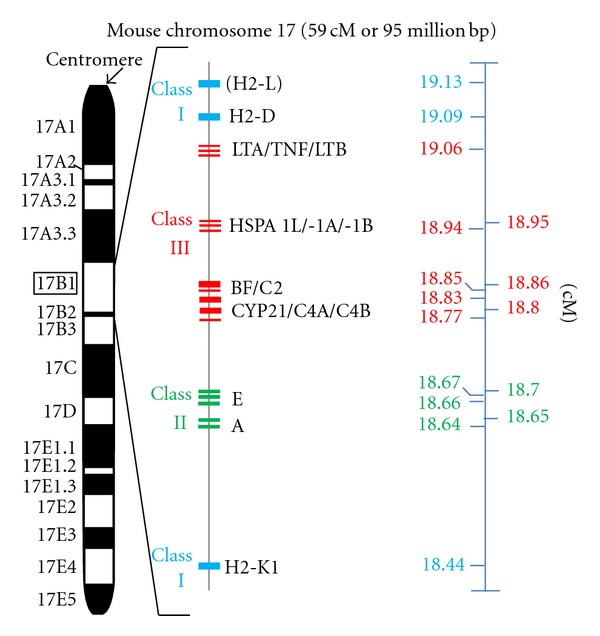Figure 2.

H-2 gene cluster and lupus susceptibility genes on mouse chromosome 17. Ideogram of chromosome 17 (middle) and schematic diagram of the MHC-complex-associated genes at 17 B1 (boxed left). The coding region of the genes is shown as small blue (class I), green (class II), and red (class II) rectangles, respectively. There are 11 mouse MHC subclasses, ranging from 18.4 to 20.3 centimorgan (cM). However, the organization of the “classical” MHC classes is similar in human and mouse. The MHC class I consists of two major loci, K and D, which are (unlike the human MHC class I counterpart) separated by the class II and class III genes. The class II gene complex is known as the I region (from “immune response”) and the class II genes are also termed “Ir genes”. Class III lupus susceptibility genes are tumor necrosis factor alpha (TNF), cytochrome P450 21-hydroxylase a1 (CYP21) as well as the complement factors C2, C4A, and C4B, respectively. Note, that cM is a nonlinear genetic distance unit of recombinant frequency, which is influenced by several factors. Further abbreviations: LTA: lymphotoxin A, LTB: lymphotoxin B, HSPA1L: heat shock 70 kDa protein 1-like, HSPA1A: heat shock 70 kDa protein 1A, HSPA1B: heat shock 70 kDa protein 1B, and BF: complement factor B. Source of mapping data: IMGT information system (http://www.imgt.org/IMGTrepertoireMHC/LocusGenes/): Artzt et al. (1991), Mammalian Genome 1: 280ff. [232], and Endo et al. [233], Gene 205: 19ff. [233].
